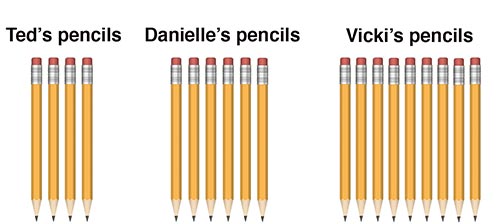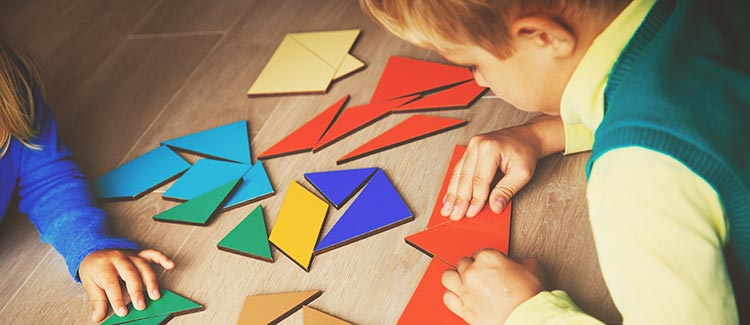Remember the shape puzzles your child toyed with — using triangles to make squares and rectangles? Turns out, that was good practice for first grade math problems.
By the end of first grade math, here are the 11 key skills your child should learn:
- Counting to 120 — starting anywhere, like from 3 or 72.
- Adding and subtracting numbers up to 20.
- Knowing that this sign “=” means equal.
- Solving word problems with three one-digit numbers (e.g. 2 + 3 + 9) that add up to 20 or fewer.
- Understanding why addition and subtraction are the reverse of each other.
- Adding up to 100, including adding a two-digit number and a one-digit number (e.g. 82 + 7).
- Knowing how to add two-digit numbers based on place value.
- Adding or subtracting 10 using mental math (e.g. 31 plus 10 is 41).
- Starting to measure things, such as figuring out how many of his footprints can fit into his dad’s footprint.
- Telling and writing time to the hour and half-hour (e.g. 1:00 pm and 1:30 pm).
- Putting two shapes together to create a new shape, and dividing shapes into two and four parts.
First grade math: Counting
Counting to 100 — that’s for kindergartners. First graders count to 120, but the catch is that they can start from any number, like 72, and count up to 73, 74, 75, and so on. Kids also learn to subtract numbers up to 20, like 19 – 7 = 12. Students learn to solve word problems using objects, drawings, and, yes, even equations. For example, if Ted has 4 pencils, Danielle has 6 pencils, and Vicki has 9 pencils, how many pencils do they have all together?

Your first grader may first draw this problem and count the pencils, but by the end of the year she’ll know the equation — and how to solve it.
First graders also learn the relationship between counting, addition, and subtraction. For example, counting from 1 to 2 is the same as adding 1 + 1. Adding one more means counting up one, and adding two more means counting up two, and so on. Likewise, subtraction can be thought of as counting down or backward. Taking that a step further, kids learn to think of subtracting as the reverse or “undoing” of adding. So, for example, if 15 + 4 = 19, then 19 – 4 = 15.
First grade math: Place value
In kindergarten, your child started to learn about place value using tens and ones. In a two-digit number like 19, the 1 represents the tens and the 9 represents the ones. Now, your first grader will build on that by learning to add a two-digit number, like 54, and a one-digit number, like 5, or two-digit number that’s a multiple of 10, like 10, 20, 30, 40, etc.
One strategy your child will learn is to add the tens and ones separately.
For example: 54 + 5 = 50 + 0 = 50 and 4 + 5 = 9 for a total of 59.
And sometimes, it’s necessary to create a ten from the ones.
For example: 54 + 7 = 50 + 0 = 50 and 4 + 7 = 10 + 1. Move the 10 to the tens, so it’s 50 + 10 = 60 and 1 for a total of 61.
Your child will also be expected to figure out in her head — without counting — how to find 10 more or less than another number. If Jemma has 68 lollipops and gives away 10, she should know that’s the same as subtracting one group of tens, leaving her with 58 lollipops.
First grade math: measurement
First graders should be able to explain how long two objects are by comparing them to a third object. For example, the first piece of paper is shorter than the second piece, but longer than the third.
Kids start applying the concept of addition to measuring things. Let’s say your child uses the dog’s tail to measure the length of a blanket; he might find that the blanket is 5-and-a-half tails long. This is great practice for when the kids start using rulers.
First graders also learn to tell time (and write it down correctly, like 1:30 pm) to the nearest hour and half-hour by reading both digital clocks and the old-fashioned round clocks with minute and hour hands.
First grade math: shapes
First graders delve into the properties of shapes by combining two shapes to form a new one, such as putting two triangles together to make a square or rectangle. They’ll do this on paper (2 dimensional) and with objects (3 dimensional).

Kids also learn to divide shapes into or two or four equal parts and learn the words for those parts: halves and quarters (or fourths).

So break out the blocks and Legos and have a blast while you can still practice all of your child’s math skills at home while playing on the floor.
- What to expect in a first grade math curriculum.
- See what knowing the ones and tens places looks like in this first grade math Milestones video.
- Can your first grader solve a word problem like this?





